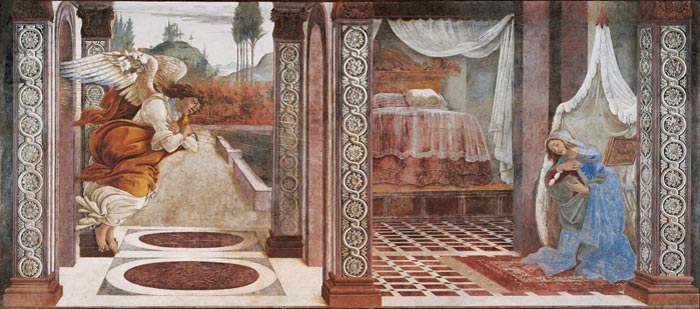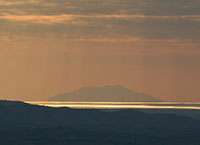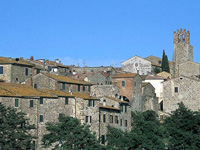 |
|
Sandro Botticelli (1444/45-1510), Annunciation (Annunciation of San Martino alla Scala) (detail), 1481. Fresco. Galleria degli Uffizi, Florence. Photo © Gabinetto Fotografico, Polo Museale, Florence |
|
Sandro Botticelli, Annunciation |
Sandro Botticelli’s painting has become a landmark of Italian Renaissance. The delicate beauty, elegant grace, and unique charm of his frequently melancholic figures make his work the epitome of Florentine painting in the Golden Age of Medici rule under Lorenzo the Magnificent. Initially trained as a goldsmith and then apprenticed to Fra Filippo Lippi, Sandro Botticelli soon ranked among the most successful painters in Florence in the second half of the quattrocento next to Verrocchio, Ghirlandaio, and the Pollaiuolo brothers. From 1470 on, he received prestigious public commissions and established himself as a painter of large altarpieces. Throughout his life, Botticelli was in the ruling Medici family’s and their supporters’ good graces. Fulfilling their wishes for innovative decorative paintings, the master could not only rely on his personal knowledge of Florentine traditions and of ancient art, but also on definite suggestions and concepts from the circle of humanists gathered around Lorenzo de’ Medici. Held in equally high esteem as both a panel and a fresco painter, Botticelli enjoyed a high standing beyond his native Florence and was thus one of the artists summoned to decorate the walls of the Sistine Chapel in Rome by Pope Sixtus IV in 1481. It was particularly his much-discussed late work that brought out the characteristic features of his original style in an extreme manner. This fresco originally hung over the entrance of San Martino della Scala, a hospital for those stricken with the plague. It was probably erected in gratitude for the end of the bout of plague which had been raging in Florence since 1478. The refinement of the colours and impressive composition of the pictorial space are still captivating features, despite the considerable damage that the work suffered in the 17th century. It was taken down in 1920 and moved to the Uffizi.
|
|
 |
|
Sandro Botticelli (1444/45-1510), Annunciation (Annunciation of San Martino alla Scala), 1481, fresco, Galleria degli Uffizi, Florence Photo © Gabinetto Fotografico, Polo Museale, Florence |
|
|
||||
 |
||||
Podere Santa Pia |
Podere Santa Pia, view from the garden on the valley below |
Century-old olive trees, between Podere Santa Pia and Cinigiano |
||
Tombolo di Feniglia |
Monte Argentario, view from Scansano |
Campagnatico |
||
 |
 |
|||
Alberese |
Montecalvello |
Sunsets in Tuscany |
||
 |
||||
| The house is set on the top of a lush hill, in a private yet not isolated spot, with breath-taking views of the sea, until Monte Argentario and the island of Monte Christo. |
||||
| A trip along the Tyrrhenian coast The Tyrrhenian Sea, a popular holiday destination in the Mediterranean, lies on the western side of the Italy coastline, northern end of Sicily and eastern side of Corsica. Going to the seaside on the northern Tyrrhenian coast, in Tuscany and Latium, is a unique experience. The name “Tyrrhenian” was derived from the Italian term “Mar Tirreno.” This Italian term, in turn, has Etruscan origins and historians believe that this name was given to the island when the Etruscan established control of an area along the coast where Tuscany is located today. The Tyrrhenian Sea was then referred to as the “Sea of Etruscans” and has always been associated to the famed Tuscan Coast, along with the rugged allure of known Italian destinations like Sardinia, Corsica and Elba. Podere Santa Pia is suitably located only 20 kilometers from Paganico and the highway Grosseto - Siena. You can easily reach some of the most beautiful beaches of Tuscany. Tuscany Beaches in Maremma | [1] From Principina a Mare to Piombino
|
||||






